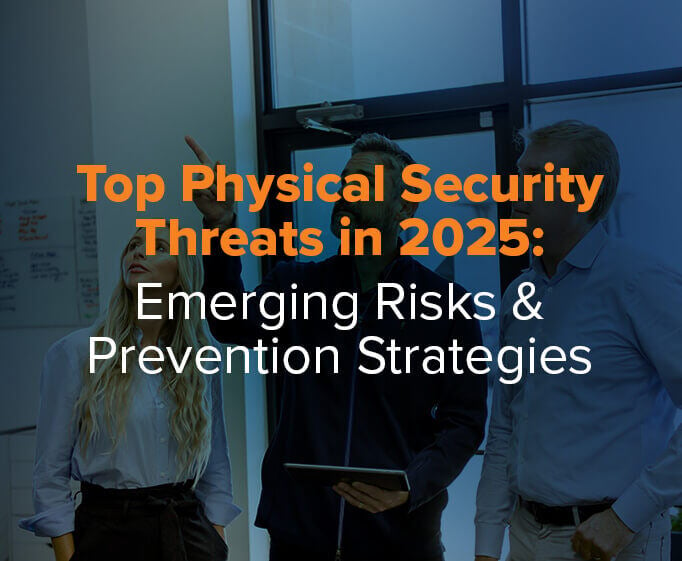By Jay Palter | May 8, 2024
Ensuring students' safety is a top priority on college campuses. But that doesn’t mean it’s easy. Educational institutions are responsible for securing several different types of facilities, from offices and cafeterias to residence halls, high-tech equipment rooms, lecture halls, laboratories, and athletic facilities. Campus security programs must find effective means for securing all of these different facilities and ensuring the safety of faculty, staff, and students.
Issues such as theft, violence, and sexual assault are significant concerns that can impact students' ability to pursue their education. Additionally, universities house a wealth of sensitive information, including financial details, academic records, and personal data, which are bound by strict regulations. Given these challenges, campus security teams must be vigilant and proactive, continuously updating their strategies to counteract the latest threats.
However, one of the unique challenges of campus security is balancing those efforts with the need to maintain an open, accessible, and welcoming educational environment. To maintain this balance and adapt to changing needs, universities can benefit significantly from integrating the latest smart security technologies. Upgrading smart security systems for campuses with modern tools strengthens security and provides the flexibility needed to manage and evolve campus safety protocols effectively.
What is campus security smart technology?
The "smart" in smart technology is used to stand for a particular type of computer chip monitoring called Self-monitoring, Analysis, and Reporting Technology (S.M.A.R.T.). Today, the term simply refers to any technology that allows otherwise offline devices to interact with users, administrators, and other campus safety solutions.
In campus security, many different assets can be smart devices, including security cameras, access control points, and smart storage systems. Devices are typically connected or controlled via Bluetooth, Wi-Fi, or sometimes direct wired connections.
Key security challenges faced by educational institutions
Integrating access control systems into a single integrated security management platform offers many key benefits. Some of the most impactful include:
Keeping campus security plans up to date
If you’re standing still, you’re falling behind. That applies doubly so to security. One of the foremost challenges for educational institutions is keeping the smart campus security plan current and responsive to the latest threats.
The security landscape is continuously changing, with new threats emerging that were not considered significant in the past. These include active shooter scenarios, cyber-physical attacks, and terrorist activities. Security teams must be equipped and ready to respond swiftly and efficiently to these incidents to protect campus communities.
Security across distributed campuses
Universities and other institutions with multiple campuses face unique challenges in ensuring uniform safety measures across all locations. This situation demands a well-coordinated approach involving deploying advanced security technologies such as video surveillance, access control systems, asset storage and management solutions, and real-time location tracking to safeguard students and staff across different geographic areas.
Reaching all students and staff
Communicating effectively with every large and geographically dispersed university community member can be challenging. Security teams must establish reliable and clear communication channels to ensure that all students and staff are informed and can receive timely updates during emergencies. This includes implementing comprehensive mass notification systems to reach everyone during critical situations.
Comprehensive regulations
Enhancing safety on campuses also often requires adhering to important regulations. These ensure transparency, accountability, and a proactive approach to managing safety risks.
The Clery Act
A pivotal piece of legislation, the Clery Act, mandates that colleges and universities participating in federal financial aid programs publicize their safety policies and crime statistics annually. This federal law holds institutions accountable for reporting campus crimes. It enhances campus safety by requiring all pertinent crimes, including those that may occur off-campus, to be disclosed to the community. Additionally, these institutions must provide timely warnings about potential threats that could impact campus safety.
The Family Educational Rights and Privacy Act (FERPA)
FERPA is a federal law that protects the privacy of student education records. FERPA applies to all schools that receive funds under an applicable program of the U.S. Department of Education, and it grants specific rights to parents regarding their children's education records. These rights are transferred to the student at the age of 18.
Under FERPA, parents and eligible students have the right to inspect and review the student's education records maintained by the school. Schools must provide security to protect all stored records from unauthorized physical and network access. Generally, schools must have written permission from the parent or eligible student to release any information from a student's education record.
The Violence Against Women Act (VAWA)
VAWA imposes requirements on universities to develop specific policies and procedures to address issues of sexual violence, domestic violence, and stalking. This includes mandatory training for handling such incidents and establishing comprehensive protocols for reporting, investigating, and resolving cases.
Regulations for Laboratory Environments
University laboratories involved in government-sponsored research face additional regulatory considerations. Labs must comply with safety standards and regulations set forth by the sponsoring government agencies, such as the USDA, NIH, or NSF. This compliance ensures that laboratory environments are safe for all participants and that the research does not pose undue risks for lab members, animal subjects, or the recipients of research.
Smart Key & Asset Management Solutions for K-12 Schools, Colleges, and Universities
Keep your campus organized using smart key and equipment management solutions from Real Time Networks. Automate transactions 24/7 whenever students, faculty, or staff need to sign an asset in or out.
Focus on deterrence strategies
In any sector, the most effective form of protection is preventing security incidents from occurring in the first place. This holds for smart campus security as well. Reacting to events such as vandalism, fires, or assaults can consume important work hours, and resolving these issues might extend over weeks or even months, significantly draining resources. On college campuses, the challenge intensifies due to additional legal requirements for incident reporting. Adopting a proactive stance on crime prevention conserves time and money and alleviates many logistical complications. It is a key campus security best practice.
The U.S. Department of Education supports this proactive approach. Its Readiness and Emergency Management for Schools (REMS) Technical Assistance Center encourages higher education safety planners to adopt a 5-step preparedness plan that prioritizes preemptive measures. REMS emphasizes the importance of establishing smart security systems for campuses that aim to prevent incidents, proactively safeguard lives and property, and mitigate the impact of potential threats.
Learn More:
Homeland Security - Guide For Developing High-Quality School Emergency Operations Plans
How can smart technology improve campus safety?
Families invest heavily in their children’s higher education. The last thing they ever want to worry about is their safety on campus. Smart technology, particularly smart security systems for campuses that incorporate enhanced data gathering and analytics capabilities, is critical to enhancing campus safety. These systems can detect suspicious persons, unusual behavior, vehicles, and even potential weapons. Upon detection, they can alert security personnel and local authorities while activating physical security measures like door locks and alarms.
Smart access and storage systems
Controlling who can enter and move around campus facilities is a critical concern for university administrators. Modern campuses increasingly utilize access control systems incorporating digital credentials on smartphones or mobile devices, chip-embedded ID cards, or biometrics. Biometrics, which verify identity through unique physical characteristics such as facial features, iris eye scans, or fingerprints, are particularly effective for securing sensitive areas like labs, offices, residential buildings, or storage systems for sensitive electronics, lab materials, and security equipment that require restricted access.
Learn More: Integrating Physical Access Control and Asset Control Systems

Surveillance and monitoring enhancements
No security team can monitor every part of a campus around the clock. Administrators are integrating surveillance cameras, smart access control tools, and asset surveillance tools into their security strategies to extend their reach. The systems are connected to unified security management platforms that support remote monitoring, analytics, and real-time management, whether on or off-campus. AI integration within camera systems can analyze video feeds for suspicious or abnormal activities, alerting security personnel immediately for rapid response. This integration reduces the need for continuous manual monitoring and allows security personnel to focus on other critical tasks.

IoT security capabilities
Threats to safety aren’t always human. Environmental hazards like fires, floods, or gas leaks are serious concerns, especially if engineering or research laboratories are on your campus. IoT technology expands the reach of your monitoring and offers extensive security capabilities, from acoustic and temperature sensors to detectors for smoke, indoor air quality, carbon monoxide, and illegal substances. Smart IoT devices such as automated locks and security lighting can further bolster security by programmatically securing premises during non-operational hours.
Learn More: What You Should Know About IoT Security Solutions

How can smart security systems help with campus security?
Smart security systems for campuses are critical in bolstering security by managing who can access facilities and vital assets. Here are just some of the benefits of smart security on campuses:
Controlled access for authorized users
Smart security systems ensure that only authorized personnel have access to specific university assets. These systems allow campuses to set specific times for access to various areas, keys, or equipment, preventing unauthorized use, especially during non-operational hours.
Creating audit trails
A comprehensive access control system maintains detailed records of who accessed what resources and when. This capability is vital for tracking misplaced keys or swiftly addressing thefts and other security violations. Immediate access to this data significantly aids quick investigations and improves the security response.
Increased accountability
Smart security systems enhance accountability among students and staff by monitoring and recording their activities. Individuals are more inclined to handle university property with care because their actions are tracked. This accountability ensures that users follow best practices and maintain the integrity of campus assets.
Enhanced efficiency
Smart security systems increase operational efficiency by automating access permissions based on roles, departments, or specific campus policies, thus reducing the need for manual oversight and decreasing the likelihood of human error. This automation frees security personnel to focus on more proactive safety tasks and facilitates collaborations with local authorities to strengthen campus security.
Promoting regulatory compliance
A user-friendly access control system, easily managed from various devices like PCs, tablets, or smartphones, simplifies security procedures for all users, irrespective of their technical proficiency. This accessibility fosters a positive approach to adhering to safety protocols on campus.

Build a Comprehensive Campus Security Plan
Develop and implement a robust security strategy that protects your people, assets, and information.
Subscribe to our blog

Jay Palter
Vice President of Marketing & Partnerships




